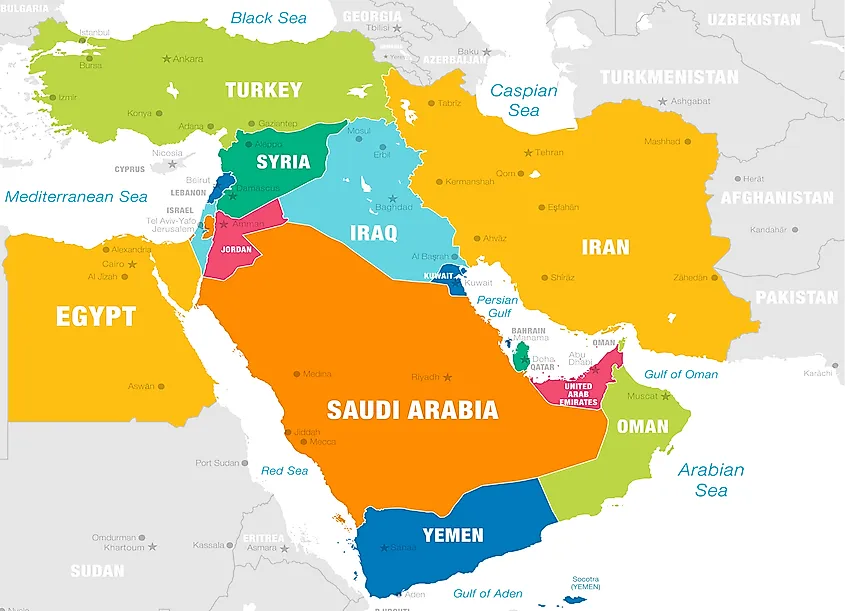
What is US policy in the Middle East?
The strong economic transformation of the United States and the devastating two world wars shattered the political structure of ancient Europe and allowed it to occupy a central position in global politics until the middle of the twentieth century. After the collapse of the Soviet Union, the United States’ only strong international rival in 1991, and the end of the Cold War in 1991, it became the world’s only superpower.
At the beginning of the twentieth century, the Middle East did not play an important role in US foreign policy. However, this policy began to change after the 1950s. Since then, Washington has focused on the Middle East and has become a major power in the region with great political influence.

The US interest in the region is based on rich hydrocarbon resources. But he had to fight for cheap, billions of dollars worth of oil. The basis of US interests in the Middle East; It created an artificially unstable military-political situation in the region and, by maintaining this situation, prevented the intervention of other world superpowers in the region and ensured the flow of cheap oil.
Since 2001, at the initiative of the United States and Britain, the Middle East has become a dangerous region in the world. In the 1990s, there was a fight against terrorists in the Middle East. That struggle has changed dramatically since al-Qaeda’s September 11 attack on the United States. Following this incident, the United States made a radical change in its Middle East policy. Thus, foreign policy was based on interference in the Middle East. Under the guise of “undemocratic regimes” in the region, military-political intervention and the overthrow of their governments, the intention to bring democracy to the region and, most importantly, the fight against terrorism were the main goals.

The United States saw unstable regimes in the region as a major threat to its energy security and sought to overthrow them. An example of this is the overthrow of the Prime Minister of Iran, Mohammad Mussadiq, who was elected by a majority of votes on August 19, 1953. On March 8, 1951, the US Central Intelligence Agency (CIA) was ordered to overthrow Mohamed Mussadiq because of his close involvement in the adoption of the law on the nationalization of Iranian oil, and the CIA allocated $ 1 million to achieve this goal. It is also worth noting the overthrow of Saddam Hussein’s regime on May 1, 2003. It is no coincidence that the United States was involved in the 1990 Iraq-Kuwait and indirectly Iraq-Iran, as well as the 2003 Iraq war.
The short history of the state of Israel is characterized by wars. The Arab-Israeli conflict is not based on eternal hatred, but on issues such as territorial claims, access to waterways, and strategic planning. Therefore, another important factor in US Middle East policy is to ensure the security of the state of Israel, the historical development of the US-Israel alliance, the importance of Israel’s geographical position for the US, and the US-Israeli peace process. can be shown to do.
Where is the region called the Middle East?

Geographically, economically or politically, regions are formed according to their characteristics. At the same time, languages, religions or denominations can be used as a basis for the formation and definition of the region. In short, meaningful and systematic common features must be found when defining a region. Given these principles, there is no definition of a region called the Middle East. The geography known today as the “Middle East”; The Turkish-Iranian basin (Turkey, Iran, Afghanistan) consists of the Arabian Peninsula (Saudi Arabia, Bahrain, United Arab Emirates, Kuwait, Oman, Qatar, Yemen), the so-called Crescent (Iraq, Israel, Jordan, Lebanon, Syria) and Egypt on the African continent.The Middle East is a region with a very large territory and always attracts the attention of major powers due to its oil reserves. It covers an area of about 15 million square kilometers and has a population of 450 million. The boundaries of the region cannot be clearly drawn, but the biggest factor determining the boundaries is the strategy of the United States of America (US) at different times.The Middle East is almost the cradle of civilizations and a region where Islam, Christianity and Judaism originated and spread. In addition to these features of the region, which has very important transit routes in the world in terms of the sea basin (Suez, Straits, Persian Gulf, etc.), it is of vital importance from the economic point of view. 70% of the world’s oil reserves and 35% of natural gas reserves are in this region. Achieving dominance in the region, seizing a state, or maintaining world hegemony allows one to have the power to decide how much to produce and consume.

As a result, US policy in the Middle East, while maintaining its political stability in the region, has shown that conflicts in the region can only be resolved by it. to pursue an independent policy and, finally, to show all mankind that it is the only “Super Power” in the world.
If you look closely at history, you will see that there is no event without the involvement of the United States. All countries, transnational corporations, companies, international organizations, including the UN, NATO, the most powerful military organization, and many other entities, directly or indirectly under the command of the United States. This begs the question: perhaps the United States is behind all these events in the world today…

